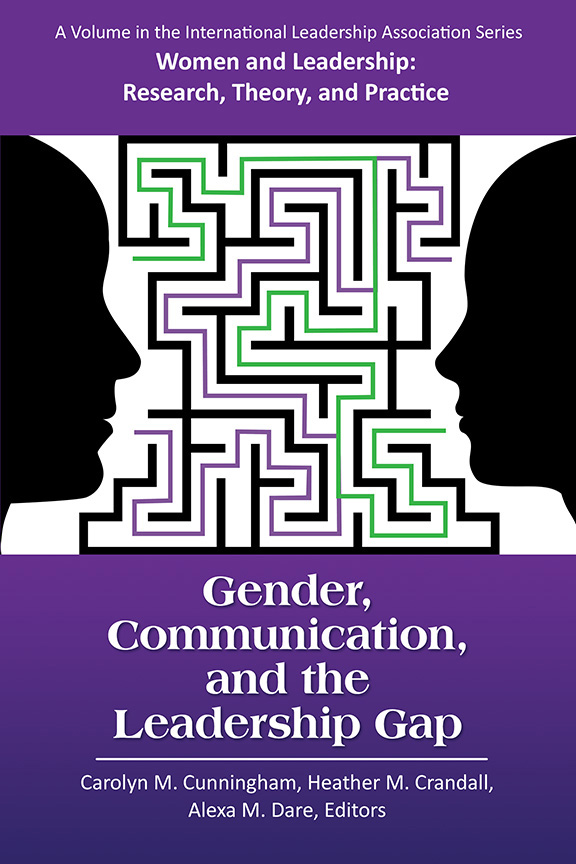Description: Gender, Communication, and the Leadership Gap is the sixth volume in the Women and Leadership: Research, Theory, and Practice series. This cross-disciplinary series, from the International Leadership Association, enhances leadership knowledge and improves leadership development of women around the world. The purpose of this volume is to highlight connections between the fields of communication and leadership to help address the problem of underrepresentation of women in leadership. Readers will profit from the accessible writing style as they encounter cutting-edge scholarship on gender and leadership. Chapters of note cover microaggressions, authentic leadership, courageous leadership, inclusive leadership, implicit bias, career barriers and levers, impression management, and the visual rhetoric of famous women leaders.
Because women in leadership positions occupy a contested landscape, one goal of this collection is to clarify the contradictory communication dynamics that occur in everyday interactions, in national and international contexts, and when leadership is digital. Another goal is to illuminate the complexities of leadership identity, intersectionality, and perceptions that become obstacles on the path to leadership.
The renowned thinkers and scholars in this volume hail from both Leadership and Communication disciplines. The book begins with Sally Helgesen and Brenda J. Allen. Helgesen, co-author of The Female Vision: Women’s Real Power at Work, discusses the two-fold challenge women face as they struggle to articulate their visions. Her chapter offers six practices women can use to relieve this struggle. Allen, author of the groundbreaking book, Difference Matters: Communicating Social Identity, discusses the implications of how inclusive leadership matters to women and what it means to think about women as people who embody both dominant and non-dominant social identity categories. She then offers practical communication strategies and an intersectional ethic to the six signature traits of highly inclusive leaders.
Each chapter includes practical solutions from a communication and leadership perspective that all readers can employ to advance the work of equality. Some solutions will be of use in organizational contexts, such as leadership development and training initiatives, or tools to change organizational culture. Some solutions will be of use to individuals, such as how to identify and respond productively to micro-aggressions or how to be cautious rather than optimistic about practicing authentic leadership. The writing in this volume also reflects a range of styles, from in-depth scholarship that produces new knowledge to shorter forums that feature interesting ideas worth considering.
About the Co-Editors
Carolyn M. Cunningham is an Associate Professor of Communication and Leadership Studies at Gonzaga University, where she teaches classes in communication theory, communication technologies, and women and leadership. She is the editor of Social Networking and Impression Management: Self-Presentation in the Digital Age. Her research interests lie in the intersections of gender and technology.
Heather M. Crandall is faculty member at Gonzaga University, an Associate Professor in the Master of Arts program in Communication and Leadership Studies, and an Affiliate Faculty member in the Women’s and Gender Studies Department. She teaches courses in women, communication and leadership, theorizing communication, small group and interpersonal communication, rhetoric, organizational communication, and media literacy
Alexa M. Dare is an Assistant Professor of Communication Studies at the University of Portland. She researches “embodied action,” focusing on how bodies organize and are organized, especially in activism and social change initiatives. She has written about memes, protest, and police violence; the embodied dimensions of transnational collaboration; implications of disembodied online education; and how pregnant workers negotiate work spaces
Table of Contents
Foreword: Lisa J. Brown
Introduction: Carolyn M. Cunningham, Heather M. Crandall, & Alexa M. Dare
- Gender, Communication, and the Leadership Gap – Sally Helgesen
- Women as Inclusive Leaders: Intersectionality Matters – Brenda J. Allen
- Narrowing the Leadership Gap: Communication Strategies to Combat Microaggressions – Kelly Lynch McKenzie & Tammy J. Halstead
- Confronting Implicit and Benevolent Bias in Teams: Concepts and Communication Strategies for Women in Leadership – Steve Mortenson
- Talking Power: Women’s Experiences of Workplace Conversations – Anne Murphy
- Embracing and Contesting Gender Roles: Communication Strategies of Women in Engineering Leadership Roles – Sarah E. Riforgiate & Emily M. Ruder
- Gender, Authentic Leadership, and Communication – E. Anne Christo-Baker & Daniel Stuart Wilbur
- The Efficacy of Strategies to Elevate Gender Equality in Leadership – Wilma Henderikse, Annemieke van Beek, & Babette Pouwels
- The Leaky Leadership Pipeline in France: A Study of Career Levers and Barriers to Foster Women’s Leadership Development – Christine Naschberger, Camilla Quental, & Céline Legrand
- Emergent Yet Constrained: Interrogating the Relationship between Leadership, Gender, and Courage in Organizing for Peace – Stacey L. Connaughton & Jasmine R. Linabary
- Transcending Self: An African Girl’s Journey – Rosemary Muriungi
- Intersectionality and Feminist Praxis: An Interdisciplinary Framework to Examine Assets and Advantages in Women’s Leadership – Diane A. Forbes Berthoud
- She Just Doesn’t Seem Like a Leader: African American Women College Presidents and Rhetorical Leadership – Dorine L. Lawrence-Hughes
- I Am versus I Will Be a Great Leader: Using Critical Race Feminism to Explore Gender Differences among College Students of Color – Annemarie Vaccaro & Melissa J. Camba-Kelsay
- Mexican American Women Leaders: Filling a Gap in the Study of Gender, Communication, and Leadership – Yolanda Chávez Leyva & Patricia Dennis Witherspoon
- Theorizing and Researching Gender and Digital Leadership in “Tech Cities” – Mariann Hardey
- The Links of LinkedIn: Impression Management on Professional Social Media – Evelyn H. Thrasher
- Leader or Lady? The Visual Rhetoric of Hillary Clinton’s Twitter Images – Newly Paul & Gregory Perreault
- Her Gospel Truth: Bloggers Rewriting Grand Narratives of Women of Faith in Church Leadership – Karen Sorensen-Lang




